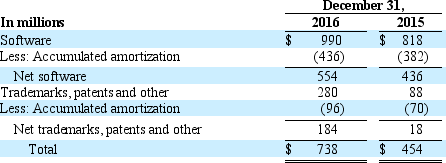The following is from footnotes from the Mega Power, Inc. 2016 annual report (in millions):
The following table summarizes the changes in the carrying amount of goodwill for 2016 and 2015:
 Intangible assets that have finite useful lives are amortized over their estimated useful lives. The following table summarizes our other intangible assets with finite useful lives that are subject to amortization:
Intangible assets that have finite useful lives are amortized over their estimated useful lives. The following table summarizes our other intangible assets with finite useful lives that are subject to amortization:
 Amortization expense for software and other intangibles totaled $128 million, $114 million and $138 million for the years ended December 31, 2016, 2015, and 2014, respectively. Internal and external software costs (excluding those related to research, re-engineering and training), trademarks and patents are amortized generally over a three to 12 year period. The following table represents the projected amortization expense of our intangible assets, assuming no further acquisitions or dispositions.
Amortization expense for software and other intangibles totaled $128 million, $114 million and $138 million for the years ended December 31, 2016, 2015, and 2014, respectively. Internal and external software costs (excluding those related to research, re-engineering and training), trademarks and patents are amortized generally over a three to 12 year period. The following table represents the projected amortization expense of our intangible assets, assuming no further acquisitions or dispositions.

Under GAAP for goodwill, we have the option to first assess qualitative factors to determine whether it is more likely than not that the fair value of a reporting unit is less than its carrying value as a basis for determining whether it is necessary to perform an annual two-step goodwill impairment test. The two-step impairment test is now only required if an entity determines through this qualitative analysis that it is more likely than not that the fair value of the reporting unit is less than its carrying value. In addition, carrying value of goodwill must be tested for impairment on an interim basis in certain circumstances where impairment may be indicated. When we are required or opt to perform the two-step impairment test, the fair value of each reporting unit is estimated by discounting the after tax future cash flows less requirements for working capital and fixed asset additions. Our reporting units are generally defined as one level below an operating segment. However, there were two situations where we have aggregated two or more components which share similar economic characteristics and thus are aggregated into a single reporting unit for testing purposes. These two situations are described further below. This analysis has resulted in the following reporting units for our goodwill testing:
●Within our Components segment, emission solutions and filtration have been aggregated into a single reporting unit.
●Also within our Components segment, our turbo technologies business is considered a separate reporting unit.
●Within our Power Generation segment, our generator technologies business is considered a separate reporting unit.
●Within our Engine segment, our new and recon parts business is considered a separate reporting unit. This reporting unit is in the business of selling new parts and remanufacturing and reconditioning engines and certain engine components.
●Our Distribution segment is considered a single reporting unit as it is managed geographically and all regions share similar economic characteristics and provide similar products and services.
No other reporting units have goodwill. Our valuation method requires us to make projections of revenue, operating expenses, working capital investment and fixed asset additions for the reporting units over a multi-year period. Additionally, management must estimate a weighted-average cost of capital, which reflects a market rate, for each reporting unit for use as a discount rate. The discounted cash flows are compared to the carrying value of the reporting unit and, if less than the carrying value, a separate valuation of the goodwill is required to determine if an impairment loss has occurred. In addition, we also perform a sensitivity analysis to determine how much our forecasts can fluctuate before the fair value of a reporting unit would be lower than its carrying amount. We performed the required procedures as of the end of our fiscal third quarter and determined that our goodwill was not impaired. At December 31, 2016, our recorded goodwill was $890 million, approximately 90 percent of which resided in the emission solutions plus filtration reporting unit. For this reporting unit, the fair value of the reporting unit exceeded its carrying value by a substantial margin. Changes in our projections or estimates, a deterioration of our operating results and the related cash flow effect or a significant increase in the discount rate could decrease the estimated fair value of our reporting units and result in a future impairment of goodwill.
A. How much goodwill did Mega Power, Inc. report on its 2016 balance sheet? How much accumulated amortization was included in that amount? Explain.
B. How much impairment charge relating to goodwill did Mega Power, Inc. report in 2016 and what was the reason for this?
C. What was the value of intangible assets on Mega Power, Inc.'s 2016 balance sheet? How much accumulated amortization was included in that amount?
Correct Answer:
Verified
View Answer
Unlock this answer now
Get Access to more Verified Answers free of charge
Q46: Brick Company had the following transactions and
Q47: The 2016 annual report of Major Bank
Q48: Following is a portion of the investments
Q49: Following is a portion of the investments
Q50: See the Future Corporation reported the following
Q52: Why do corporations undertake intercorporate investments? How
Q53: Companies are required to disclose both qualitative
Q54: Refuse Disposal Inc. reports the following in
Q55: Explain the standards which determine if an
Q56: What is meant by significant influence? Describe
Unlock this Answer For Free Now!
View this answer and more for free by performing one of the following actions

Scan the QR code to install the App and get 2 free unlocks

Unlock quizzes for free by uploading documents